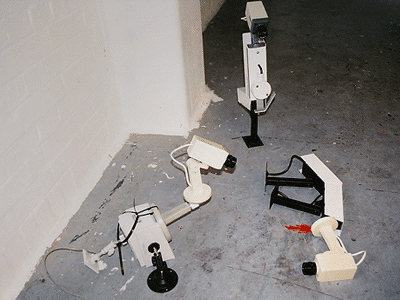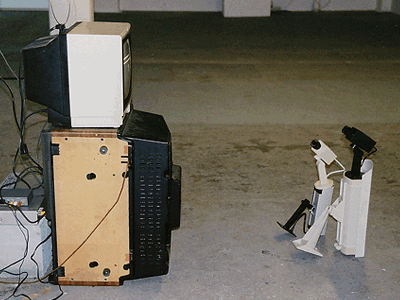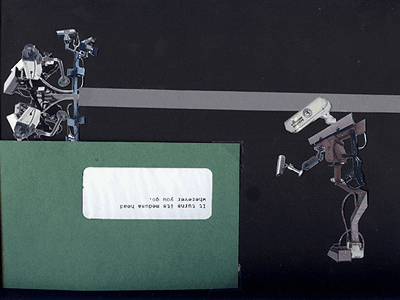ASBO [by Pil and Galia Kollectiv]
Kollectiv's website

The presence of CCTV equipment in urban centres can be felt everywhere, from reality TV shows to late night corner shops, concealed in neo-classical domes above suburban malls and in trees in city-parks. London has the largest number of closed circuit cameras in the world, while Johannesburg's city centre is covered with cameras that can zoom in on any person walking on street level and follow them. During a normal day in the city centre, one is likely to be filmed over 400 times. In a recent postal strike, post office authorities suggested implementing CCTV to observe illegal strikers. At first, this seems like a very intimidating situation, but we have come to look at surveillance cameras as wildlife in our new urban nature. We would like to form a relationship with the machines that surround us by exploring the world from their perspective and seeing in them a reflection of human society. We call our little camerabot friends ASBOs because we think this acronym for anti-social behaviour orders also sounds like a kind of creature that could be friendly as well as menacing. It's a tragic-comic name for a tragic-comic creature. Our work, both in these installation pieces and in the film and collage work that has accompanied them, asks how panic and insecurity are being visualised in contemporary culture, and whether this results in "the defence of luxury lifestyles...by a proliferation of new repressions in time and movement" (Mike Davis, City of Quartz, 1990), or is CCTV closer to the utopian role that Dziga Vertov assigned to the camera: "I, a machine, am showing you a world, the likes of which only I can see" (Dziga Vertov, "Manifesto of the Beginning of 1922). Placed in their own Œnatural' habitat, taken away from their original function and placed in full view, do hidden cameras still somehow retain the sense of paranoia and the power structures that were programmed into their very existence or do they speak a language all their own?

